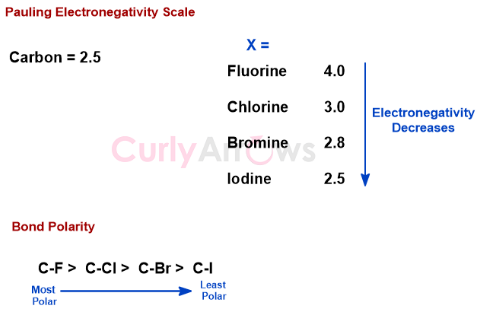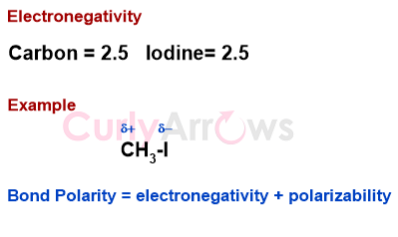In the carbon-halogen covalent bond, the halogen due to its higher electronegativity pulls the electrons in the bond towards itself. The unequal sharing of the bond electrons results in carbon to be electron-deficient and halogen, electron-rich. This charge redistribution is shown with a partial positive charge (δ+) on the carbon and a partial negative charge (δ-) on the halogen. Such polarized bond is called a polar covalent bond.
Electronegativity Difference of a Carbon Halogen Bond
Fluorine is the most electronegative element in the periodic table and is assigned a value of 4. The electronegativity of halogens decreases from the top to the bottom elements in the periodic table, and therefore it is least for Iodine.
A Carbon-Fluorine bond is the most polar, and Carbon-Iodine is the least.

Carbon-Iodine bond
The electronegativity value of Carbon and Iodine is 2.5. There is no difference in electronegativity, and therefore, it must be a non-polar bond. However, the bond polarity depends not only on the electronegativity difference but also on the atoms' polarizability.
Polarizability is defined as the ability of the atom’s electrons to distort or shift due to external influences- an external electric field or nearby polar molecules.
Amongst the halogens, Iodine has the largest size due to the presence of more electrons in multiple shells. The large size makes attractive nuclear force for the outer electrons ineffective. They are therefore available for distortion or polarization.
The distortion of Iodine’s electron cloud in a reaction medium with other polar molecules induces polarity in the Carbon-Iodine bond. This induced polarity creates a δ + Carbon and δ - Iodine to form a polar covalent bond.

The Bond length of the Carbon-Halogen Bond
Halogen’s size increases on going down the column in the periodic table; therefore, on forming a bond with Carbon, the Carbon-Halogen bond length also increases. Since Fluorine is the smallest element and Iodine the largest, Carbon-Fluorine Bond is the shortest and the Carbon-Iodine bond the longest.
The Bond Enthalpy of Carbon-Halogen Bond
In a longer Carbon-Halogen bond, the atoms are farther apart and require less energy to break. The energy is called the bond enthalpy. It is minimum for the Carbon-Iodine bond and maximum for, Carbon-Fluorine Bond. High bond enthalpy makes the Carbon-Fluorine bond in fluoroalkanes highly unreactive and Iodoalkanes very reactive.
The Dipole moment of the Carbon-Halogen Bond
Dipole moment (µ) calculates a molecule’s polarity. It considers the electronegativity difference that leads to the separation of charges (q) and the distance between the two charges (d).
µ= q x d
As electronegativity and the bond polarity decreases from Fluorine to Iodine, the dipole moment is expected to decrease. However, the dipole moment of Chloromethane is greater than that of Fluoromethane. This is due to the short Carbon-Fluorine bond length. Therefore, though the C-F bond is most polar and leads to greater charge separation, its shorter bond length affects the dipole moment (µ). The dipole moment of Fluoromethane is, therefore, lower than Chloromethane.
Attempt this quiz to check your understanding of this concept.